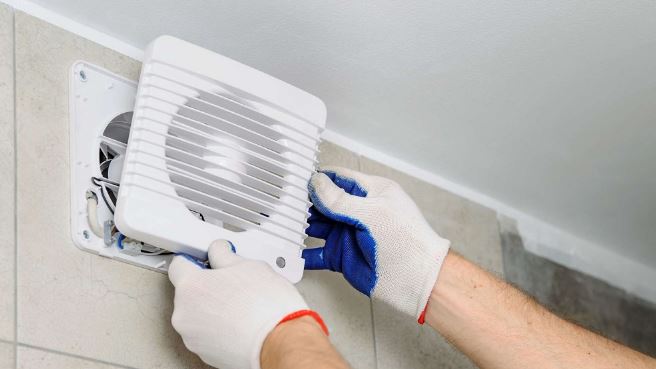High-quality bathroom ventilation is a prerequisite for comfortable and safe use of the toilet. Properly organized ventilation in the bathroom solves many problems, be it an unpleasant smell, heavy damp air or mold formation. The main thing is to properly equip the bathroom, using modern devices: an exhaust fan, a heating system under the floor covering, a plumbing hatch under the tiles and much more. We will tell you how to properly organize the space of the bathroom for effective air exchange and combat dampness.
Why is proper ventilation in the bathroom important?
The presence of adjustable air exchange is important for any room. But ventilation is especially relevant for small enclosed spaces, which include the bathroom. Increased air humidity, water splashes, lack of windows and a constantly closed door to the bathroom lead to condensation and dampness in the bathroom – an ideal environment for various fungi, including mold.
Excessive moisture has an adverse effect on air quality, room decoration and household appliances, and spoils textiles – towels, clothes, shower curtains. Forced ventilation in the bathroom helps to correct the situation, which will allow:
- remove water vapor in a timely manner;
- improve air quality by preventing air stagnation;
- get rid of constant fogging of mirrors, glass, tiles and any smooth surfaces.
Ventilation standards
Sanitary standards and building regulations provide for a certain intensity of air exchange for separate bathrooms and combined bathrooms. The minimum standard values are 10 m³/hour (for bathrooms) and 20 m³/hour (for combined bathrooms), the maximum are 90 m³/hour and 120 m³/hour, respectively. To ensure the required level of air exchange, not only natural ventilation in the bathroom is used, but also specialized equipment: exhaust fans, check valves, etc., as well as auxiliary devices to combat dampness. This combination will allow you to achieve the right microclimate in the room even with active use of the bathroom.
Solutions to combat dampness in the bathroom
There are several ways to reduce humidity in the bathroom:
- installation of a heated floor system – heating the floor covering prevents moisture condensation and accelerates the drying of surrounding surfaces after taking a shower or bath;
- replacing the heated towel rail with a more powerful one – it will help heat the surrounding air and quickly dry towels that absorb moisture and unpleasant odors;
- installation of the “Praktika” hatch on the screen under the bathtub – such a solution will not only provide free access to meters, filters and pipes, but will also allow you to ventilate the space hidden behind the screen. You can buy a hatch under the bathtub under the tiles in various design options and sizes, depending on the area of the room and its arrangement.
But still, the main way to get rid of excess dampness and moisture is the exhaust fan for the toilet and bathroom. Using an exhaust fan will allow you to immediately remove polluted air saturated with water vapor, freeing up space for fresh flows.
The construction market offers many options for fans, differing in the method of installation and material of manufacture. But the main selection criteria here are the shape of the product, which is determined by the configuration of your ventilation duct, power and the presence of additional useful functions.
How to calculate the optimal fan power
The calculation of the required power for ventilation in the bathroom can be done as follows:
- Measure the total volume of the bathroom. Multiply the length, width and height of the room to get the volume in cubic meters;
- Calculate the optimal indicators. You can determine the ventilation performance in two ways – by focusing on the standards specified above (suitable for constant exhaust ventilation), or taking into account the air exchange rate (optimal for periodic ventilation of the bathroom). Since most fans provide for periodic switching on, it is better to focus on the air exchange rate when calculating, which is 6-8 full updates per hour (the choice of rate depends on the number of people living and the intensity of use of the bathroom). Determine the fan power by multiplying the volume of the room by the rate.
Example: the volume of a bathroom with an area of 1.95 m and a ceiling height of 2.5 m is 4.875 m³, we multiply it by a factor of 6 (since only two people use the bathroom), and we get an optimal performance of 29.25 m³/hour.
A similar calculation is also applicable to the exhaust hood in the toilet in the apartment.
Important: do not purchase a fan with a “reserve” of power, since such a device will consume more electricity, create additional noise and may require the installation of a special supply valve.
Additional fan capabilities
Modern manufacturers know how to make bathroom ventilation as convenient as possible with the help of various fan options. They offer a wide range of models equipped with:
- delay timer – allows the fan to operate for a set period of time after the light is turned off, removing residual moist air and unpleasant odors;
- humidity sensor – due to it, the device is triggered automatically when the humidity in the room increases.
Conclusions
Proper ventilation in the bathroom is an important aspect of maintaining a healthy and comfortable microclimate in your home. Using exhaust fans and auxiliary solutions to combat dampness, you can ensure optimal conditions in the bathroom and avoid problems associated with excess moisture.
